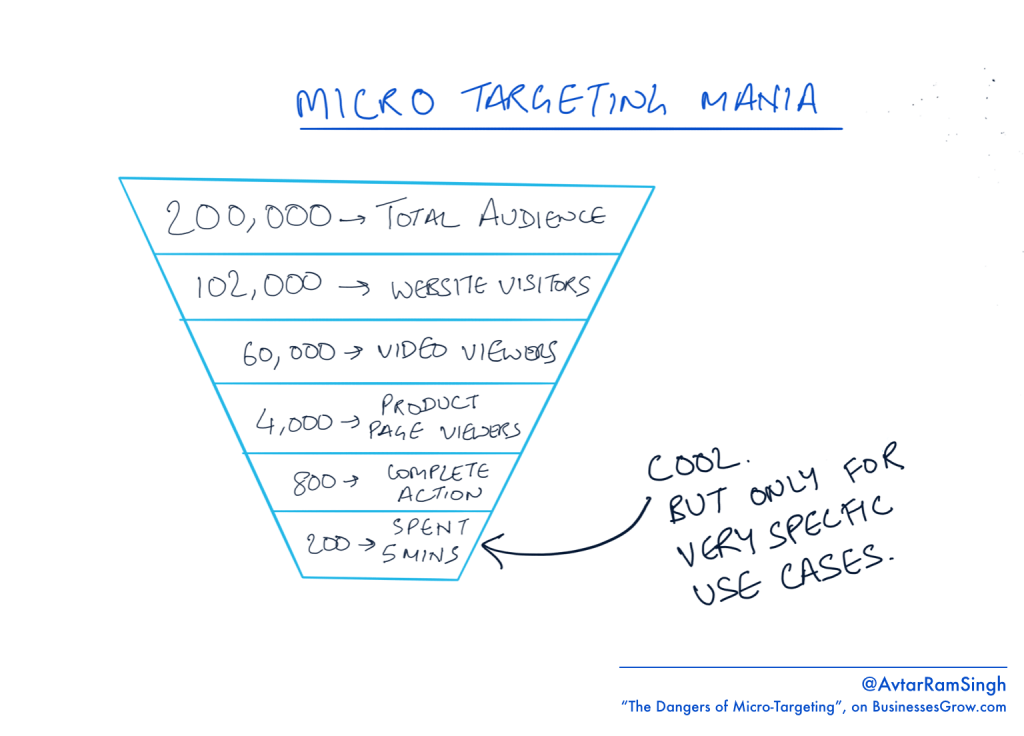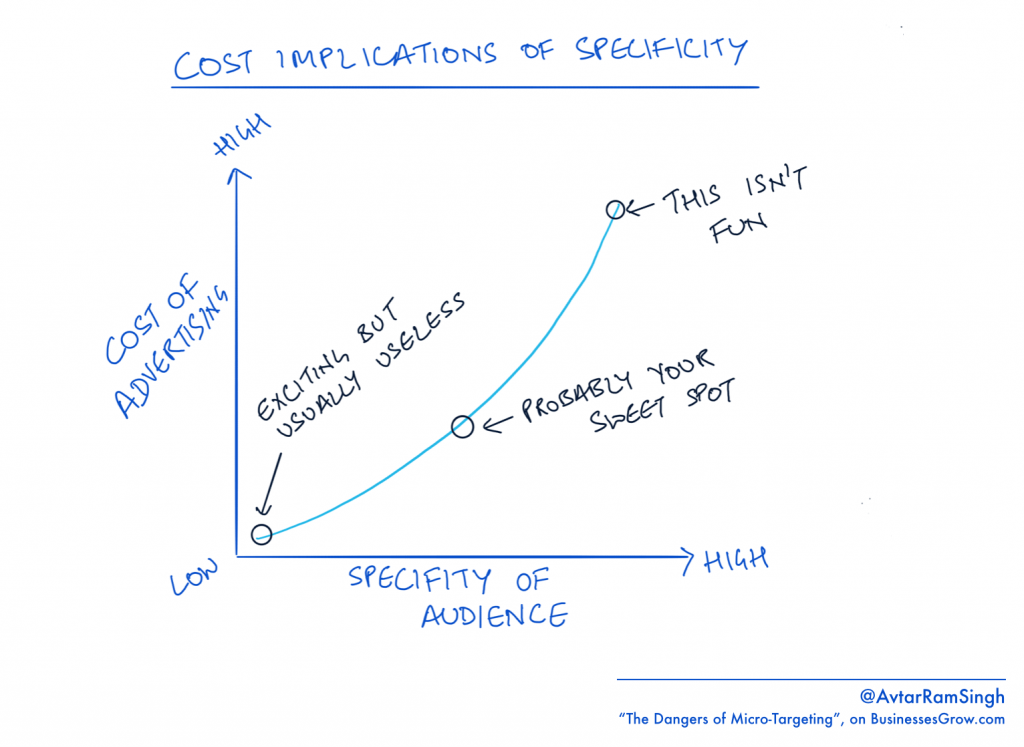By Avtar Ram Singh, {grow} Contributing Columnist
A persistent marketing best practice is to niche-down and create micro-target markets. Today, I’m going to explain why that might not be a good idea.
A couple of decades ago, if you wanted to target an affluent demographic, you’d print flyers and have them snail mailed to the expensive neighborhoods in the city.
Today, with the micro-targeting possibilities that search engines and social networks offer, targeting “the rich” is considered silly and “too broad.” Since Facebook and Google offer you far more intricate targeting features, why not use them?
So we end up with situations like this:
- Target consumers aged 25-30, that live in a specific location, have engaged with your page in the last 30 days, have bought a product from you in the last 90 days, have watched two specific videos to 50% completion and have visited a particular product page in the last 7 days.
- Target consumers that have visited your product page and the pricing page in the last 7 days, have seen your product video to 75% completion, have initiated a checkout on your website but haven’t completed it, and have in the last 180 days spent at least $200 on your website.
If you’ve got the right tracking pixels and conversion events set up on your Facebook ads account, you can most definitely do this.
But just because you can do it, doesn’t mean you should.
In all likelihood, doing the above for most marketers will lead you to targeting perhaps 1,000 people in the first instance, and about 200 in the second.
The cost of targeting a granular niche audience is actually pretty high, and let’s be honest, even if you put those filters on your targeting, what does it really mean?
A Little Detail is Enough Detail
If you’re looking to target a highly engaged audience, simply targeting people that have watched a few of your videos to a significant completion rate should be enough. If you’re looking for high converting and high value audiences – targeting people with an AOV (Average Order Value) of $250-$350 from your e-commerce store is enough.
Just because specific features are available to us, doesn’t mean that we have to use them. Just because Facebook and Google allow us to do something, doesn’t mean doing so is always a good idea.
With the level of intricacy and the depth of targeting available to us, a greater danger arises. Our focus on finding micro-audiences leads us to ignore the true marvel in marketing – the content and the value being delivered to the audience.
Audience Insights vs Business Insights
I’ve always believed that micro-audiences never reveal a business insight about your product’s messaging, value proposition, consumer journey or design. If a micro-audience of 800 people converts well – the insight or learning in all likelihood – is particular to that very specific audience.
They’re audience insights, not business insights.
They’re along the lines of, “People that view multiple pieces of content to a high completion rate convert 4x better than a cold audience”. That’s actually a pretty obvious discovery, and a hypothesis that you technically shouldn’t have to test.
On the other hand, if you’re targeting a wide audience of 250,000 people – and you discover that when testing eight different messages, the click-through on a particular message and value proposition was a lot higher, you end up with an observation along the lines of, “People convert 5x better when product feature X was highlighted”.
That’s a business insight.
It adds value to more than just the marketing team in your organisation.
One could argue that you can test eight different messages across eight different audiences, and potentially come up with the same conclusion. But think about the cost of doing so in terms of time, effort, and money.
Focus on the Message, and the Value Delivered
Targeting consumers with incredible specificity is not an excuse for tardy and poorly planned communications and creative. It’s dangerous to believe that because you’re getting so specific with your audience and you know they’re interested in your product, you can get away with shoddy messaging.
You might actually end up hurting your brand more than building it. Imagine if this person — an avid consumer of your product — receives a piece of content from you that’s poorly thought out. They’ll begin to think less of your brand, and you might actually end up alienating them.
Many marketers are focused on niche-targeting and playing with very specific targeting at the expense of creative content, but your focus should be on delivering exceptionally high consumer experiences with great creative to help you stand out in a sea of sameness.
It’s always worked, and it will always work.
Don’t Throw Micro-Targeting Out the Window
I’m not dissing the ability to micro-target. I’ve used it on many campaigns over the last few years and enjoyed success in the majority of cases. Knowing when to use specific targeting however, is key.
- Micro-targeting, as much as possible, should be behaviour based.
- If you’ve just put up a post on your blog in the “tech” category, targeting people that have previously visited articles in that category on your blog and are in the top 25% in terms of “time spent” on your website is a micro-targeting execution that makes sense.
- Micro-targeting is useful to help someone complete a step in a specific journey, such as complete signing-up (if they stopped mid-way) or initiate a checkout (if they abandoned a high value basket).
- Micro-targeting can be useful to test a specific hypothesis about a particular audience and introduce a shift, such as in your low value members or passive high value members.
You get the gist.
Quite often, a fair number of tools and possibilities available to us on digital platforms are fun to tinker with, but more often than not, can end up being a distraction from the true purpose of our marketing.
Don’t let it distract you from your core proposition.






